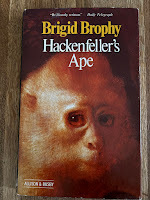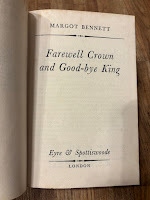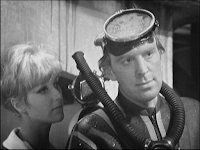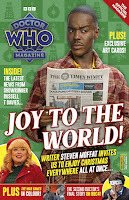Simon Guerrier's Blog, page 10
December 13, 2024
Hackenfeller’s Ape, by Brigid Brophy
 Professor Clement Darrelhyde spends his days at London Zoo, singing opera by Mozart to one of the enclosures. Despite this encouragement, Percy and Edwina — two specimens of Hackenfeller’s Ape (Anthropopithecus Hirsutus Africanus) — continue not to mate, though she seems more in favour than he does. Then Darrelhyde learns than Percy has been sold to the space programme and will, in just a few days, be blasting off in a rocket on what’s likely to be a one-way trip.
Professor Clement Darrelhyde spends his days at London Zoo, singing opera by Mozart to one of the enclosures. Despite this encouragement, Percy and Edwina — two specimens of Hackenfeller’s Ape (Anthropopithecus Hirsutus Africanus) — continue not to mate, though she seems more in favour than he does. Then Darrelhyde learns than Percy has been sold to the space programme and will, in just a few days, be blasting off in a rocket on what’s likely to be a one-way trip.Darrelhyde attempts to fight the bureaucracy and rouse the interest of the press in his efforts to save Percy. When this fails, he teams up with a young pick-pocket called Gloria to free Percy from his cell…
This short (125 page), funny novel begins with a neat reversal, describing the behaviour of a particular species of ape which, we come to realise within a few sentences is us. I’ve seen this kind of anthropological inversion done elsewhere, such as in David Attenborough’s Life on Earth (1979), where the final, 13th episode looks at human beings from the same objective viewpoint it has applied to other creatures.
This sort of thing is quite common in science-fiction, too; our ordinary, unthinking behaviour suddenly strange. (I’m near the end of Adrian Tchaikovsky’s amazing Children of Time and will have more to say in due course…)
While the conceit only lasts for those first few pages, we frequently see events from Percy’s perspective. The effect of this inversion is, said a review in Time quoted in the front flap, “a pointed and amusing satire”, while the Herald Tribune thought it, “a brilliantly accomplished small book which widens out into large meanings.”
The lightness of touch surprised me given what I know about Brophy’s later campaigning on the issue of animal rights. Her name came up when I was looking into issues of personhood and reading around the documentary Project Nim, which I reviewed for the Lancet.
The novel was apparently inspired by Brophy’s time living close enough to London Zoo to hear the cries of captive animals. She later wrote a piece, “The Rights of Animals” (1965) for the Sunday Times, subsequently republished by the Animal Defence and Anti-Vivisection Society, and contributed to such publications as Animal, Men and Morals (1971) and Animal Rights: A Symposium (1979).
I’m also aware of Brophy’s effective campaigning in other areas. With Maureen Duffy she was instrumental in seeing the Public Lending Right enshrined in law, so that authors receive payment for their books being borrowed from public libraries. I’m a direct beneficiary, a fact I have to declare at each meeting of the British Library’s advisory committee to PLR. As I linger over the complimentary sandwiches, I think of Brophy and Duffy and all they achieved.
Yet this novel is not a polemic or even particularly campaigning; indeed, an anti-vivisectionist is one of the targets for satire here. Colonel Hunter of the League for the Prevention of Unkind Practices to Animals is more keen to collect and share photos of animals in distress than to stop such things actually happening. There are no goodies or baddies, just a lot of different frail and fallible people with their foibles.
Elsewhere, a newspaper won’t get involved because they’ve already decided to support the nascent space programme and run a “Space corner” each Saturday. This, we’re told is,
“For the kids. It does them less harm than sadistic comics.” (p. 43)
That’s a sign of the time in which this was written; the anxiety about American comics warping impressionable minds led to the creation of the far more wholesome, home-grown Eagle, launched in 1950. This novel is a counterpoint to the optimistic future lavishly displayed each week in the Eagle’s cover strip Dan Dare. The idea that the space programme could conscript an ape from the zoo is perhaps informed by the shadow of war. The professor’s boarding house and the niceties of dinner with his sister all seem from another age.
It’s been interesting to read this, by chance, after another novel from the same year. It is very different to Farewell Crown and Good-bye King, more in tune, I think, with something else from 1953: Nigel Kneale’s TV serial The Quatermass Experiment has a similar ambivalence to the space programme and the costs involved. But what really struck me about this novel was how modern it feels. I can see why it still felt relevant enough in 1979 to be republished in hardback — the edition I read.
One reason for that is the treatment of impulse and desire, whether ape or human, unworried by social convention. At one point, Gloria daydreams of an encounter with an imagined, handsome young man, who she tellingly gives the name of the aged professor. When, in reality, a young man then asks her out, the relationship lasts only briefly.
“I wasn’t flash enough for her,” (p. 124).
Percy being at liberty transforms his sex drive but his freedom is short-lived. Kendrick, the young man from the space programme, has to hastily improvise an alternative to using Percy that further blurs the distinction between primitive ape and sophisticated human. There’s something both comic and disturbing in all this. When Percy returns to his enclosure of his own volition, Gloria asks what he’s up to.
“Darrelhyde repressed the first word that came to mind. ‘Mating,’ he answered.
“Oh.” Perhaps with cold, Gloria shuddered, and then giggled slightly. “Aren’t animals awful?” (p. 92)
December 12, 2024
Doctor Who Magazine Yearbook 2025
 The 2025 yearbook from Doctor Who Magazine is now out, featuring a couple of things typed by me.
The 2025 yearbook from Doctor Who Magazine is now out, featuring a couple of things typed by me.Pages 28 and 29 relive the experience, in May, of watching season opener Space Babies for the first time, my son the then 12 year-old Lord of Chaos keen to see it at midnight - especially if we had crisps. Then, on page 68 and 69, we mark the 40th anniversary of The Who Shop on 2 December, with an interview with owners Alex and Kevan.
December 10, 2024
Farewell Crown and Good-bye King, by Margot Bennett
 After so enjoying Margot Bennett’s 1952 crime novel The Widow of Bath, I plunged into her next novel, a thriller first published in 1953. It’s not nearly as good, yet full of things of interest.
After so enjoying Margot Bennett’s 1952 crime novel The Widow of Bath, I plunged into her next novel, a thriller first published in 1953. It’s not nearly as good, yet full of things of interest.The plot is quite involved so I’ll endeavour to explain the set-up. In the first chapter, we meet wealthy Barry and Vanessa Bone as they return home late from a posh party, arguing about the cheque for £2,000 that Barry has just given Roger Maple. The money, insists Barry, is as an investment in a new railway in an eastern European country called Ardania, where copper has been found; Maple is a friend of the local king.
A young woman called Kate Browning returns home from the same party and admits to her sober, level-headed sister Julia that she overheard Maple and the Bones, got mixed up in their conversation after she claimed to know the king as a friend of a friend, and has herself invested £100 in the scheme. Yet Kate believes that the money is an investment in a deal to distribute Ardanian oil.
Vincent and Frances Roydon were also at the party. Vincent is features editor of the Vigilant newspaper, which is ironic as he, too, has been hoodwinked by Maple, investing £250 that he can ill-afford in what he thinks is a paper-making scheme to exploit Ardania’s plentiful soft woodlands.
In the second chapter, we meet Maple himself, calling in on his old friend Duncan Stewart, an impoverished documentary film-maker who finds £250 to invest in what Maple describes as a scheme to dam Ardania’s Lixaman Falls and supply hydroelectric power across the border.
By now the reader is sure of what Duncan only suspects: that all of this is a scam. Maple conspicuously leaves the remains of a letter from a mystery woman, Elvira, in Duncan’s wastepaper bin and then heads off to meet his wife, Jenny Maple, so they can leave the country.
He promptly disappears. Jenny tells Duncan that her husband stood her up but she refuses to go to the police, even as days turn to weeks without word from him. Duncan instead meets the other hoodwinked investors and together they investigate what has been going on. Their first move is to try and meet up with Ardania’s former king, now living in London under the name Mr Forster and busy trying to agree the sale of his unrivalled collection of paintings by Vermeer…
 That is just the start. This is all fiendishly complicated and yet the mystery at the heart of it I very quickly guessed, not least because the fictional, mittel-European country of Ardania put me in mind of The Prisoner of Zenda. As with The Widow of Bath (and the Sherlock Holmes story The Adventure of Silver Blaze), the behaviour of a dog is an important clue — in this case, the telling feature is that the dog does bark. But I think the whole thing might have been more effective if the dead body found in water late on in the novel happened much earlier on, with these people then all involved in solving a murder, not just trying to retrieve their investments.
That is just the start. This is all fiendishly complicated and yet the mystery at the heart of it I very quickly guessed, not least because the fictional, mittel-European country of Ardania put me in mind of The Prisoner of Zenda. As with The Widow of Bath (and the Sherlock Holmes story The Adventure of Silver Blaze), the behaviour of a dog is an important clue — in this case, the telling feature is that the dog does bark. But I think the whole thing might have been more effective if the dead body found in water late on in the novel happened much earlier on, with these people then all involved in solving a murder, not just trying to retrieve their investments.Even so, the novel is full of brilliant details and Bennett shows her usual sharply observational eye. Roger Maple, before he disappears, is a beguiling rogue with a neat line in tradecraft. For example, he advises Duncan Stewart not to buy beer on credit from his local shop:
“It gives you a reputation of being hard up, and in your own street, too.” (p. 22)
It doesn’t matter that Duncan is hard up; the important thing is appearance. Maple instead recommends being bold and try cashing a cheque for £100 in the same establishment to give a contrary impression. Then there’s the artful way Maple gives the names of his other investors — Bone, Browning and Roydon — to sufficiently impress Duncan that he wants to put in money himself, while thinking this is his own idea (p. 28). In doing so, the author also provides Duncan with leads to follow when Maple disappears, bringing the different investors together to compare stories and so form a bond. That is elegantly, effectively done.
Speaking of bonds, I wondered at first why Duncan was so easily taken in by Maple, given he’s such an evident rogue. How did these two so very different men ever become friends? Just as I wondered this, the answer came: on p. 34 we’re told that they were in the army together. The implication is that this formed an unshakeable bond between two people otherwise from completely different worlds. Now I wonder how relatable that would have been to readers of the time, so soon after the end of the war and with National Service ongoing. I’m aware that the services threw together people from different backgrounds and classes who might never otherwise have met. But I’d never thought of the lasting relationships so created, akin to friends made on holiday that you can’t then shake, but with a stronger, faced-death-together connection.
Another contemporary insight is Duncan’s own frustrations. As a filmmaker, he’s keen to find truth, avoid cliche and to document ordinary, real life. There's a sequence late on where he’s being briefed on an advert for serial. When he offers his view on how to lift this above cliche, he is told “This is meant to be an advertising, not an art film” (p. 166) — though the implication is that his suggestions will be taken on and will prove effective.
This and the sequence where Roydon is faced with the sack, apparently on the whim of the publisher, may reveal something of the real-life experience of the author, or her husband who was editor of Lilliput between 1943 and 1950, when Margot wrote regularly for it. How much could the Bennetts do what Roydon does here, his threat to take a scoop to a rival publication earnings him promotion and a raise? My guess is that this was wish fulfilment, even revenge for real life.
On another occasion, Duncan rails against the nannying welfare state, in much the way as might the protagonist of novels from the same year such as Ian Fleming’s Casino Royale or Nevil Shute’s time-travelling In the Wet.
“‘I can’t leave the country, drive a car, open a shop, buy a pound of butter, not without permission. There are places where I can’t cross the road until a policeman lets me. I know I’m a man and not a unit,’ he said satirically, ‘because I’m allowed to register a vote for Holborn Borough Councillors. I’d like to do something more. I’d like to find Roger and not just run bleating to the police. I’d like to be a man on my own.” (pp. 62-63)
But Duncan isn’t alone; the whole wheeze of the book is that it’s an investigation by a group of amateur detectives, all from different backgrounds but linked by common cause. Though Duncan crave adventure of a John Buchan/Richard Hannay sort, it is Roydon who enjoys racy antics abroad.
There are lots of fun supporting characters, best of all Derek Vaughn, the burglar battling with his own conscience. Here’s a typical monologue from him, all sex and violence and comedy:
“When I was a lad, I was one of the roughest types on God’s earth. I’ve done five years for rapping a harmless old woman on the head. But I used my time to educate myself, and before the end I was the prison librarian. Some of the least educated men used to be great readers They’d get me to mark off the dirty bits for them, and even if it was just the lights going out or a description of a woman’s brassiere they’d read it till the page dropped off. That way, sir, I gradually got a lot of them interest in literature for its own sake.” (pp. 73-74)
Something of this echoes in a later sex scene just kindling as a chapter ends:
“She drew his hard, reluctant body closer to her and held his head against her soft, generous breasts. She soothed him with her loving, expressive hands until he was utterly relaxed in the ambience of her kindness. He was weak, and knew for the first time the peace that comes from abandoning the painful disguise of strength.” (p. 217)
How different, I thought, to the gruff, masculine perspective of bonking in Fleming or Shute, sex as surrender rather than attack. And yet, this sex is also victory, an accomplishment and something got away with for the lover who is married to someone else.
That is more interesting than the way the novel ends for Duncan, rejected by one woman so he immediately proposes to another. We leave him and his fiancee on an ostensibly happy note, but the cold exchange of one woman for another simply doesn’t sit right. The Widow of Bath neatly tied up all the threads of its plot and added an unsettling coda to haunt us after the close of the book. The ending here is is unsettling because it is unsatisfactory, not quite tying things up. The basic trick behind this novel isn’t as clever or as satisfying as her last book, and it’s not quite so well done.
Bennett followed Farewell Crown and Good-bye King with two novels both published in 1955 which I’ve already read: unconventional mystery The Man Who Didn’t Fly and the science-fictional The Long Way Back; my friend Matthew Sweet calls the latter her masterpiece. I’ll be back to read what’s considered the best as well as the last of her detective novels, Someone From the Past (1958).
December 9, 2024
Missing Believed Wiped 2024
 I had a lovely day out on Saturday at the BFI’s Missing Believed Wiped event(s), where we got to see an assortment of old telly that had been thought lost. These events are always a thrillingly eclectic mix, some items really good and some plain boggling. Usually, it’s made up of stuff that has been returned to the archives over the preceding year but that had been a little extended to include some special items here.
I had a lovely day out on Saturday at the BFI’s Missing Believed Wiped event(s), where we got to see an assortment of old telly that had been thought lost. These events are always a thrillingly eclectic mix, some items really good and some plain boggling. Usually, it’s made up of stuff that has been returned to the archives over the preceding year but that had been a little extended to include some special items here.Session 1, which was dedicated to the memory of Rory Clark, began with Jo Griffin telling us about the restoration work done on LWT comedy series The Complete and Utter History of Britain (1969). Two episodes of this were previously known to exist, then last year the whole lot was suddenly up on Britbox, to the amazement of my archive telly pals. It turns out that the other episodes had been misfiled, all as “episode 2”.
We watched episode 6 of 8, originally transmitted on 16 February 1969. Colin Gordon is the straightman, a sort of news anchor bridging comic skits based on historical moments, all in chronological order. In this case, we covered from Guy Fawkes (here lighting a fireworks display of Catherine Wheels) to Oliver Cromwell (being interviewed on a chat show, insisting he is popular while the audience objects and throws things).
It was often very funny, such as the expert historian describing the execution of Charles I who ends up killing a member of the audience, or Michael Palin’s impression of David Frost as he interviews Terry Jones as Cromwell... as Edward Heath. Best of all, the episode ended with a sort of trailer for the next one, with a load of quick-fire visual gags. It was also often very well staged and shot, notably in the fun sequence of a witch (Jones) getting her spells wrong.
Afterwards, Michael Palin and producer Humphrey Barclay were interviewed on stage. Palin seemed gratified by the response — not least because, on broadcast, John Cleese had rung him up and told him the series wasn’t very good. Instead, Cleese invited Palin and Jones to collaborate on something else, which of course ended up being Monty Python. Palin was funny about this and the context in which the programme was made, and classy in acknowledging the excellent job done on restoration by Jo Griffin and her team.
Next up was a compilation provided by my mate Ed Stradling from TV Ark of some otherwise missing telly he’s found by looking through old VHS tapes. This included Andrew Sachs as Manuel from Fawlty Towers chaotically cooking paella on Pebble Mill At One, and a bit of a New Year’ Eve programme from the late 1970s, with two comedians dragged up as Scottish policewomen trading bawdy jokes in front of a police box that then dematerialises.
This was followed by an episode of trendy magazine programme A Whole Scene Going from 16 February 1966, in which a documentary crew visited three contrasting parties — one very posh and staid, another more down at heel — followed by a studio interview with the hosts. They discussed what made a good atmosphere and how to cope with people being drunk and sick. It was a fascinating snapshot of the time, loaded with assumptions about class and status, and all achingly awkward.
So was an interview with Dudley Moore and Shirley Anne Field, who answered “Agony Aunt” style questions about dating, such as whether it was all right to kiss at the end of a first date. Marianne Faithful was filmed at home and then live in the studio, responding to fans’ repeated displeasure that she’d got married and had a baby. Presenters, guests and audience were all so oddly nervy, none of them knowing quite how to be in front of a camera, the way people now take for granted. The sense was of precocious, well-spoken children, squirming in their seats while nervously seeking approval.
We finished the first session with an episode of Six More Faces of Jim, in this case The Face of Fatherhood from 15 November 1962. The wheeze of the series (and the preceding Six Faces of Jim) was that each episode featured Jimmy Edwards as a different role and situation — effectively a series of sitcom pilots. This episode was a bit different: a TV version of the radio skit The Glums from the 1950s, with Mr Glum (Edwards) seeking to thwart the engagement of his son Ron (Ronnie Barker) to Eth (June Whitfield). It was fun, though I felt that it maybe under-served Edwards by having him play so closely to type.
Eth is a spirited character, lawing down the law to Ron and snapping back at selfish Mr Glum. That, I think, was particularly notable after the lack of speaking women’s roles in The Complete and Utter History and the rather demure women in Scene (at one point, an audience member complains that Marianne Faithful’s marriage means he can no longer consider her angelic, and she nods along rather than punching him).
With barely enough time to wolf down a burrito, we hurried back in for Session 2, this time comprised of material recovered by Film is Fabulous. I’ve long been in awe of this project, which is really focused on ensuring that film collectors leave provision so that their collections don’t end up as landfill. But that has in turn led to a scheme to catalogue the contents of a number of collections, which has led to the discoveries of some otherwise missing telly.
John Franklin and Simon Nicholls from Film is Fabulous gave us some background and announced some new finds: a Jackanory-style programme called Storyteller from September 1956 presented by Elizabeth Beresford years before she created the Wombles and illustrated by Tony Hart; and three episodes of Douglas Fair Banks Junior Presents, also from the late 1950s.
We were then treated to something called Disc Jockey from 1960 or 1961: a series of filmed performances of pop songs, all in very good quality. Jimmy Lloyd performed “I Double Dare You” on a set that looked like a New York apartment, with well dressed young people smouldering at one another, including a black man and white woman. Another song saw Frank Ifield getting very close to a young woman in a coffee bar. Later, a young woman at the window of her house in America sang about liking the young man loitering outside but her parents wouldn’t approve. For all the lightness of the pop song, behind her there was a rifle on the wall suggesting the risk posed to the would-be amore. The whole lot felt potent and rich, and I’d love to know more about this programme.
This was followed by a series of clips from found programmes, including a thrilling sequence from Mogul: Is That Tiger, Man? (30 April 1966) in which Tiger (Michael Coles) dons scuba gear to fix an oil-pipe in shark-infested waters while being taunted by gruff bully Peter Thornton (Ray Barrett) and cooed over by Steve Thornton (Justine Lord). When the sharks come close, Tiger surfaces too quickly and gets the bends; Thornton coldly insists he be thrown back into the water to recover. This and the scene of Alec Stewart (Robert Hardy) was all of the cross business-tycoon fare that I remember once being so much part of TV drama until it was basically killed off by parody in A Bit of Fry and Laurie’s John and Peter (“Dammit John!”) — but what we saw here looked great.
We then got an episode of Tom Jones! (with exclamation mark) from 3 April 1967, comprising songs sharing a given theme, in this case Work. This ranged from a daft sequence of professional dancers fooling about in a kitchen to Jones as a miner, or working on a chain gang, or driving a truck while singing Hard Days Night. Yet when guest Maxine Brown sang about a woman’s (domestic) work, the gag was that Jones was doing the dishes, coming on with a tea towel which Brown handed back to him at the end of their flirty duet.
Finally, there was an episode of The Basil Brush Show from 20 November 1970, the CSO effects evidence that it was originally made in colour, for all it survives in black and white. The oddest thing about this, I thought, was how poorly it was pitched to the live audience of children (in their school and cub scout uniforms, all dressed up to be on TV). As Mr Derek (Fowlds) struggled not to corpse, Basil rattled off quips at the expense of women, trades union and foreigners. For example, when told he talks too much, he says it’s an inherited trait because his father was an auctioneer, his mother a woman. “Fucking hell,” responded the bloke just in front of me.
Some of the jokes earned a laugh, from the audience on screen and at the BFI, but it was notable how much less a response it got than The Complete and Utter History earlier that same afternoon. Discussing this afterwards in the bar, I wonder how much it was following the conventions of stand-up, taking as read How Jokes Are Done. So often, what makes old telly so extraordinary is the way it reveals things once taken for granted, perhaps not even thought of, that now seem so peculiar. Puzzling over these things is what makes an event like this so compelling. Television is such an intimate, immediate form, we have a particularly vivid means of travelling back in time.
See also:
Me on Missing Believed Wiped 2007Me on Missing Believed Wiped 2010My current work-in-progress: an episode guide to mostly missing BBC adventure series Garry Halliday (1959-62)December 8, 2024
The Power of 3 podcast #316: The Time-Travelling Almanac
 I spoke to Kenny Smith for his Power of 3 podcast about my new book, Doctor Who: The Time-Travelling Almanac, which would of course make the ideal Christmas gift for the Doctor Who fans in your life...Power of 3 #316: The Time-Travelling Almanac
I spoke to Kenny Smith for his Power of 3 podcast about my new book, Doctor Who: The Time-Travelling Almanac, which would of course make the ideal Christmas gift for the Doctor Who fans in your life...Power of 3 #316: The Time-Travelling AlmanacI spoke to Kenny last year about another of my books, David Whitaker in an Exciting Adventure with Television; that podcast is available here and you can still buy the book.
(The photograph above right shows two copies of the Time-Travelling Almanac plus my copy of Kate Orman's 1994 Doctor Who novel The Left-Handed Hummingbird.)
December 6, 2024
Doctor Who Magazine #611
 The new issue of the official Doctor Who Magazine is out now, boasting a preview of the forthcoming Christmas special and the colour version of classic 1969 story The War Games. Exciting!
The new issue of the official Doctor Who Magazine is out now, boasting a preview of the forthcoming Christmas special and the colour version of classic 1969 story The War Games. Exciting!It includes a one-page Stasis Cube by me, this time based on a photograph of David Tennant and Catherine Tate on the roof of the old International Press Centre in Shoe Lane, London, on Thursday 6 July 2006 for recording of that year's Christmas special, The Runaway Bride.
I also get a mention in the editorial because of something I've written for the Doctor Who Yearbook 2025, which is out next week...
December 4, 2024
Ten years since our eldest daughter died
 It is 10 years today since the death of our eldest daughter, Emily Maud, aged just eight days' old. I blogged about what happened that same afternoon, which seems a bit extraordinary now.
It is 10 years today since the death of our eldest daughter, Emily Maud, aged just eight days' old. I blogged about what happened that same afternoon, which seems a bit extraordinary now.Me and the Dr are fine. Well, not fine - we're both suffering physical ailments at the moment. But yesterday we took a day off together and drove up to Haworth, home of the Brontes (including Emily). We met up with one of my old school friends, had lunch in the pub where Branwell Bronte went boozing, and I bought some stocking-filler bits and bobs for Lady Vader - the beloved daughter who wouldn't even exist but for the loss of her elder sister.
That loss still hurts and haunts us. This time of year is always difficult. Last week, I thought I was okay and then wasn't. But I've found that the best way to think of the anniversary is as a place: a fixed position in Earth's orbit round the Sun every 365 and a bit days. The Earth is constantly moving, so for all we come back to the same place each year, we're always passing through and will soon be somewhere else...
The more time passes, too, the more that what lingers is the extraordinary kindness we were shown. I remain in awe of the staff at the neonatal ward at St George's Hospital in Tooting - whose brilliant work you can support with donations. There's the woman I never even met but think of all the time. I asked the medical staff where the knitted caps came from that so perfectly fitted our Emily. They told me they were knitted by a woman patient, up on the terminal ward. I wasn't allowed to go see her but sent her a note in which I could not nearly begin to express our gratitude.
Then there were the family and friends who helped us through it all, at the time we were in hospital and in the weeks and months that followed. There was nothing anyone could do to help and yet so many people did.
They're who I wrote that post for on the day she died. And what I didn't say then but will say now is: thank you.
December 1, 2024
The Widow of Bath, by Margot Bennett
 The blurb for this British Library Crime Classics edition of a novel first published in 1952 quotes praise from Julian Symons in his landmark study of the genre, Bloody Murder (1972):
The blurb for this British Library Crime Classics edition of a novel first published in 1952 quotes praise from Julian Symons in his landmark study of the genre, Bloody Murder (1972):“There are a dozen clever deceptions in the book, twice as many as most writers would have given us.”
I’ve seen some criticism that The Widow of Bath is too complicated, or its protagonists too unlikeable, or that it’s too funny (when, it is implied, murder is a serious business). But I found it fun and then compelling; the last third held me utterly gripped.
We start with Hugh Everton, dining in a down-at-heel seaside hotel — we’re never told where, only that it’s not Bournemouth (p. 25). He is caustic with the Italian waiter about the meagre fare. Then, by chance, in walks Jan Deverill, who has history with Hugh but hasn’t seen him in years.
Jan’s uncle, Gregory Bath, is with her. He’s a respected judge and married to the much younger Lucy, who also has history with Hugh (we learn later that she’s why Hugh and Jan split). Lucy arrives in the company of some other men, one of whom Hugh is certain he recognises — they had some rough dealings previously. Yet he is told he’s got this wrong; this isn’t the same man.
Though Hugh is caustic with everyone, he’s invited back to the Bath residence for more drinks and is the last person to speak to Gregory Bath before the judge is shot dead. But by the time the police arrive, the body has disappeared…
The novel is narrated in the third person from Hugh’s perspective, so really it’s he who observes that this situation is,
“the reverse of the sealed room murder” (p. 47).
Then, when questioned by Inspector Leigh of the local police about the late Judge Bath’s beloved dog, heard outside the house just before the gunshot, Hugh responds,
“He did bark in the night” (p. 50).
This is, of course, a reference to the Sherlock Holmes adventure The Adventure of Silver Blaze (1892), but it's striking that these two references to staple of the crime genre follow in such quick succession. It’s as if the author is offering her credentials: this, she’s saying, will be a reversal or twist on the classic model of a murder mystery.
Agatha Christie did something similar in creating Hercule Poirot; on page 11 of his debut adventure, The Mysterious Affair at Styles (1920), she compares Poirot to Sherlock Holmes and so indicates to the reader that this will be the same kind of story. It’s not just that Poirot is a similar kind of detective (with his own individual quirks) but also the “rules” of the story are the same as in the best of Holmes, allowing the reader a fair chance to crack the case ahead of the detective.
Ronald Knox famously codified these rules in an introduction to The Best Detective Stories of the Year 1928 (1929), in what is sometimes known as his “10 commandments” of detective fiction, or the detection decalogue. The Widow of Bath doesn’t break any of these, as such, but I think it comes pretty close.
Hugh doesn’t light on any clues that are not instantly produced for the inspection of the reader. Yet on several occasions, some new fact or revelation means more to him that it does to us — for example, it relates to his rough treatment with the man he recognises at the beginning of the book, or it’s something he remembers reading about in the papers. It’s not quite playing the game, which I think is why I think aficionados of crime might object.
But I also think this stuff makes the novel more than just a game. What starts as a cosy crime caper riffing on a version of the locked room becomes something a bit stranger and richer.
It’s an odd mix of ingredients. The austere, respectable judge and his young, flighty wife are rather stock characters. There’s a rather Dickensian father, so obsessed with a legal case and his old, out-of-date papers that he neglects his daughter. And then there’s stuff that feels very contemporary.
The plot reminded me of Ian Fleming’s Moonraker, published two years later, which also involves a group of people who are hiding in plain sight. Like Nevil Shute’s The Far Country — from the year before this — there’s an unease about the post-war settlement. Here, Inspector Porthouse notes that, unlike everyone else, criminals are able to save money, in what feels like side-eye at the post-war Labour government:
“They don’t get it all taken off them as tax” (p. 201)
Rather than things being settled by the end of the war, the world continues in chaos, with Hugh listing multiple competing tensions:
“Even now there were plenty of people on the run in Europe. Communists were chasing capitalists; dictators hounding democrats; socialists hunting fascists. People on top everywhere were persecuting the people who had fallen to the bottom; the old scores were a short list compared to the new scores; the secret police were, as usual, being secret only up to a point; their intentions were frequently public and alarming; the results then achieved gave only slender assurance to the law-abiding. The mass activity of armies was restricted; the private efforts of generals, and even, sometimes of corporals, were disastrously free.” (p. 176)
For all this is going on “in Europe”, some of it reaches this quiet seaside town — if only the people there will take the trouble to notice. Early on, Judge Bath is shocked by Hugh’s lack of morality when presented with evidence of a crime. The judge sees things simply:
“And I also advise you that it is the duty of every citizen to expose and so help to destroy evil.” (p. 31).
It seems odd to hear this case being made with no reference to Hugh having recently been demobbed — we presume — from battling Nazis. Notably, there’s little sense of what the various characters did during the war. But I think this is all informed by something else: the author’s time in Spain during the civil war, and her efforts to campaign in London to raise money to battle the fascists. There’s something a little like Casablanca (1942) here: an amoral man hidden away in a coastal resort who encounters an old flame and discovers a cause he will fight for.
I wondered at first if Hugh’s experience of war explained his caustic nature; he;’s a sort of bitter Bertie Wooster. “If you go on like this I’ll have to hit you,” Hugh says to the the grieving widow Lucy (p. 42). He then tells her to think of something cheerful such as what she’ll wear to the murder trial, before adding that this is all a “kind of verbal anti-hysteria slap, containing no malice.”
To some extent, this is a defensive response following his previous rough treatment. We learn that while previously involved with Lucy, Hugh got caught up in a scam that saw him disgraced at work, he was then pushed into the Seine and nearly drowned, before ending up in prison. But this caustic stuff is also familiar from the other Margot Bennett novels I’ve read. As I said of her The Long Way Back (1955), sexual attraction seems to make people more caustic with each other and sex is bound up with the threat of violence.
Despite Hugh’s instincts to protect himself and not get involved in this mystery, he is drawn into investigating the crime. He generally blunders around and at one point it looks as though he has thwarted years of painstaking police work. The inspector duly explodes,
“God spare me from amateurs” (p. 202).
It’s a fun twist on the form to suggest that the amateur detective has in fact hampered the investigation. Yet on the same page it’s suggested that perhaps the police had no idea about the scheme Hugh has uncovered but are pretending otherwise. We’re not sure who to believe.
Things take a more serious turn when Hugh realises that someone else is at risk. There’s palpable horror when it seems Hugh has endangered them. Another character dies and their body also disappears — and the story really picks up. By the end, Hugh has taken on the moral imperative that he dismissed at the start of the novel: he is determined to catch the criminals and see them brought to justice.
We then get twist after twist, pop-pop-pop. I correctly guessed one villain — I’m not sure it’s much of a surprise. But then it turns out that the death of Gregory Bath is not quite what people have assumed. Hugh gets a happy ending but then there’s a coda in which we learn the cost to someone of this cosy caper.
This is a bleak note to end on, again with some ambiguity about exactly what this person will now do. It’s unsettling and lingers in the memory; it is highly effective.
Margot Bennett adapted her novel for television, broadcast by the BBC over six weeks from 1 June to 6 July 1959, with a preview written by Bennett published in Radio Times. John Justin played Hugh, with his real-life wife Barbara Murray as Lucy. Jennifer Wright played Jan (a few months ahead of joining the cast of Garry Halliday in the regular role of Jean Wills). Sadly, the serial doesn’t survive in the archives but it marked a significant shift in Bennett’s career.
She’d previously written a one-off, hour-long TV play, The Sun Divorce, broadcast on 26 January 1956 as part of Associated Rediffusion’s London Playhouse on the relatively new ITV (which launched the previous October), and then wrote 15 episodes of the soap opera Emergency-Ward 10 (1958-59). She also co-wrote two films: The Man Who Liked Funerals and The Crowning Touch (both 1959).
But the adaptation of The Widow of Bath was her first work for the BBC, presumably under the auspices of the head of script department there, Donald Wilson. Over the next few years, she went on to write for a number of major BBC crime and thriller series: The Third Man, Suspense and Maigret.
“It seems that Bennett found screenwriting more lucrative than producing novels at a time when she was also raising a family,” says Martin Edwards (p. 10) in his introduction to the British Library Crime Classics edition of another of her novels, The Man Who Didn’t Fly, originally published in 1955. That book was nominated for the very first Golden Dagger award for best novel of the year, as given by the Crime Writers’ Association. (Until 1960, the Golden Dagger was known as the Crossed Red Herring award).
A later novel, Someone from the Past (1958) won this coveted award and in 1959 Bennett was made a member of the prestigious Detection Club. “She had reached the pinnacle of her profession,” as a crime writer says Edwards, but “astonishingly, she never published another mystery novel, an extreme example of a crime writer going out at the top” (p. 9).
I’m fascinated by all of this: the range of an extraordinary writer, the economics involved, the practicalities, the implicit politics. More to follow when I finish Bennett’s Farewell Crown and Good-bye King (1953).
November 22, 2024
London Rules, by Mick Herron
 The fifth instalment in the Slow Horses series is another involving and fun thriller, the established characters joined by a host of new, well drawn and enjoyably fallible figures. The novel opens with a terrorist attack that is really shocking, and then a smaller-scale attack on one of the regulars. We follow our heroes' attempts to uncover what's behind these two attacks and the mounting suspicion that they might be connected.
The fifth instalment in the Slow Horses series is another involving and fun thriller, the established characters joined by a host of new, well drawn and enjoyably fallible figures. The novel opens with a terrorist attack that is really shocking, and then a smaller-scale attack on one of the regulars. We follow our heroes' attempts to uncover what's behind these two attacks and the mounting suspicion that they might be connected.Often the focus is on hacker Roderick Ho: his personal and home life, the thoughts bubbling away in his head, the way his perspective is completely at odds with what's really going on or what people actually think of him. This works to great effect, at once funny and suspenseful because we understand what he doesn't: that's he's in genuine danger.
Just as we think we know where we are with all this, a leading character is killed in a clumsy, accidental encounter that has major repercussions - a good example of Herron's knack for keeping things surprising and suddenly upping the stakes. As we know from previous novels in the series, no one is safe in these stories and regular characters can be killed abruptly.
That makes the final act especially thrilling, with two regulars out on their own dealing with... well, that would be spoiling things. Herron keeps us on tenterhooks about which, if either of them, are going to survive. And then, in the closing moments of the novel, there's the tantalising suggestion that someone we thought dead in a previous book is still alive and there is more story to come...
It'll be interesting to see how this instalment is adapted for TV, not least because the last TV series ended on something of a cliffhanger about the status of Frank Harkness, the character played by Hugo Weaving. There's little mention of him here but I suspect he'll have more of a role on screen.
Again, I'm in awe of audiobook narrator Sean Barrett bringing so many characters to life. We're never in any doubt who is thinking or speaking. I made a note early on that it is sometimes confusing when we change scenes, or locations, without much pause in narration. Yet as things went on, I began to think that this was highly effective, the plot relentless and the listener required to pay attention. That and the constant guessing game of what's really going on and who is going to survive make this an immersive novel and rewarding to part of.
November 21, 2024
Daleks: The Ultimate Guide
 Out today, this massive and comprehensive 224-page bookazine from the makers of Doctor Who Magazine is full of everything you could possibly want to know about Daleks.
Out today, this massive and comprehensive 224-page bookazine from the makers of Doctor Who Magazine is full of everything you could possibly want to know about Daleks.With Dalek expert Gav Rymill, I’ve written 28 entries on different models of Dalek, charting their evolution from the very first Dalek story in 1963-64 to their more recent full episode, 2022’s Eve of the Daleks. There are some new facts and insights included, such as my outlandish theory about when and why writer Terry Nation decided to make them look the way they do.
Each entry is illustrated with a CG rendering of the particular model by Chris Thompson.
Simon Guerrier's Blog
- Simon Guerrier's profile
- 60 followers



